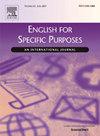探索跨学科边界:BERTopic建模方法在抽象和句子层面分析四个跨学科领域
IF 2.7
1区 文学
Q1 LINGUISTICS
引用次数: 0
摘要
跨学科研究在应对复杂的全球挑战方面发挥着核心作用;然而,它的语言实现尚未得到充分的探索。本比较研究使用BERTopic(一种利用句子嵌入的上下文敏感主题建模方法)来研究跨学科学术写作的主题结构。利用来自四个成熟的跨学科领域——生物医学工程、环境科学、认知科学和数字人文学科——的4000篇研究摘要的语料库,本分析在两个粒度级别上比较了主题结构:摘要和单个句子。在抽象层面上,六个主要主题表现出强烈的学科一致性,这表明即使在明确的跨学科领域,边界仍然突出。然而,句子级建模揭示了一个更复杂的景观,包含80个细粒度主题,其中包括特定学科和多学科类别。后者可分为共同研究焦点、方法趋同和研究实践。这些发现表明,虽然跨学科写作保留了核心学科身份,但它表现出跨领域的选择性语义整合。本研究进一步认为,成熟的跨学科领域是比较语篇分析的连贯单位。它促进了跨学科的话语,并为ESP研究提供了启示。本文章由计算机程序翻译,如有差异,请以英文原文为准。
Exploring interdisciplinary boundaries: A BERTopic modeling approach to analyze four interdisciplinary fields at the abstract and sentence levels
Interdisciplinary research plays a central role in addressing complex global challenges; however, its linguistic realization remains underexplored. This comparative study investigated the thematic structures of interdisciplinary academic writing using BERTopic, a context-sensitive topic modeling method, which leverages sentence embeddings. Drawing on a corpus of 4,000 research abstracts from four mature interdisciplinary fields – biomedical engineering, environmental science, cognitive science, and digital humanities – this analysis compared topic structures at two granularity levels: abstracts and individual sentences. At the abstract level, six dominant topics exhibited a strong disciplinary alignment, indicating that even in explicitly interdisciplinary domains, boundaries remained prominent. However, sentence-level modeling revealed a more complex landscape with 80 fine-grained topics, which included both discipline-specific and multi-disciplinary categories. The latter were classified into shared research focus, methodological convergence, and research practice. These findings suggested that, while interdisciplinary writing retained core disciplinary identities, it exhibited selective semantic integration across fields. This study further argued that mature interdisciplinary fields served as coherent units for comparative discourse analysis. It contributed to the interdisciplinary discourse and offered implications for ESP research.
求助全文
通过发布文献求助,成功后即可免费获取论文全文。
去求助
来源期刊

English for Specific Purposes
LINGUISTICS-
CiteScore
5.70
自引率
8.00%
发文量
41
审稿时长
62 days
期刊介绍:
English For Specific Purposes is an international peer-reviewed journal that welcomes submissions from across the world. Authors are encouraged to submit articles and research/discussion notes on topics relevant to the teaching and learning of discourse for specific communities: academic, occupational, or otherwise specialized. Topics such as the following may be treated from the perspective of English for specific purposes: second language acquisition in specialized contexts, needs assessment, curriculum development and evaluation, materials preparation, discourse analysis, descriptions of specialized varieties of English.
 求助内容:
求助内容: 应助结果提醒方式:
应助结果提醒方式:


